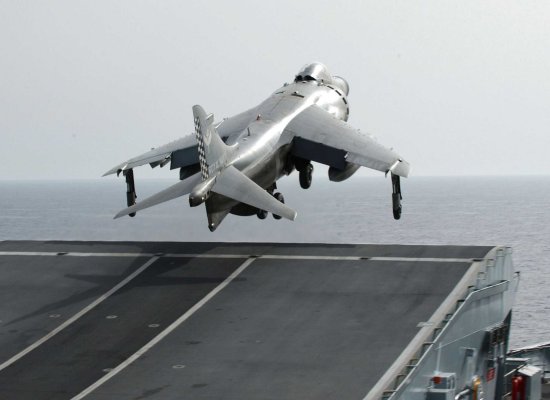UPDATED Cherry Point, NC: The Marine Corps is pushing some of its fighter aircraft to the breaking point, as the service waits for the F-35 Joint Strike Fighter.
Marine Corps fighter squadrons in Afghanistan have racked up thousands of flight hours on their legacy F/A-18 Hornets, scraping the ceiling of the 9,000 to 10,000-hour cap set by Naval Air Systems Command for the fighter jets, Capt. Stewart Wittel, a F/A-18 pilot with Marine Corps Fighter Squadron 224, told me this week.
Marine Corps Hornets completed their rotation in Afghanistan earlier this year, with the service's AV-8B Harriers now providing air power to Marines in country. The last Hornet deployment was in May, Marine Corps spokesman Capt. Brian Block said today.
But Whittel, who just returned from a deployment in Helmand province in southern Afghanistan supporting Marine Corps forces near the Sangin valley, said some squadrons are reaching service life limits with the Hornet.
The F/A-18 Hornet was designed to fly about 6,000 hours before retirement. Marine Corps pilots do not fly the newer F/A-18 Super Hornet. A Marine Service Life Extension Program (SLEP) is designed to push the limits on flight hours on from the original 6,000 hours to between 9,000 and 10,000 on the Hornet fleet. The SLEP effort was intended to keep the Hornets flying until they get the F-35.
Headquarters Marine Corps - Aviation, who oversee the service's aviation budget, were adamant the SLEP effort would go no further than the 9,000- to 10,000-hour extension.
But Block told AOL Defense that the highest average flight time on any service F/A-18 Hornet is just over 8,500 hours. "Moreover, not a single F/A-18 Hornet in the Department of the Navy inventory has surpassed the 9,000 hour mark," Block said.
But flying that close to the 9,000 to 10,000 hour ceiling is stressing out the Hornet fleet, Wittel said, especially on the maintenance side.
"It does not mean that the aircraft are still not relevant and capable of doing [the mission], it is just we are managing now the stress on the aircraft and making sure stress points on the aircraft are checked on a regular basis." he added.
That will mean more work for depot crews once the planes come home. Taking the Marines usual can-do attitude into account, an observer still has to wonder when wings will begin to crack and other bits fall off or fail.
To that point, Block said that Marine Corps crews "are conducting routine maintenance at an accelerated pace due to higher utilization" of the Hornet in theater.
But at some point, time will eventually run out on the Hornet fleet if the Marine Corps keep flying the Hornet at or near that 9,000 to 10,000-hour limit, warned Maj. Gen. Jon Davis, commander of the 2nd Marine Corps Air Wing.
"You cannot keep it up forever," Davis said to me earlier this week. "You had to do SLEP to get them out to 10,000 [already]...we want to bring F-35 into the fleet as quickly as we can, so we do not have to extend the life of those F-18s."
A congressional aide was not sympathetic to the Marines' plight as they near service life limits on the F/A/-18.
"The fact that the Marines are having a tough time is no surprise. They decided to not buy any Super Hornets and hope that their legacy Hornets would last until the JSF arrived," the aide wrote in an email. "That now looks like a really bad bet."
Flying legacy Hornets up to the flight hour ceiling is "OK here and there, but at some point the amount of maintenance required to keep those planes flying is simply unsustainable," the aide added.
Another close observer of the program who is familiar with the congressional debate, appeared relatively unfazed that the Marine planes have wracked up the hours they have. "On the other hand, this isn't a hard problem to fix -- rotate out those Hornets, rotate in others with fewer hours on them. If we're actually getting out of Afghanistan in the next year, the replacement planes shouldn't time out," this source said in an email.
Colin Clark contributed to this story.
*A previous version of this story referred to Naval Air Systems Command as Naval Air Command.




 , vậy còn kém xa con Harrier, Yak-38 roài. F-35B/C nói chung và F-35C nói riêng đều là SVTOL, tức có thể cất lẫn hạ cánh thẳng đứng thoải mái Harrier muốn xem nó hạ cánh thẳng đứng thì cứ việc coi fim "Lời nói dối chân thật" của bác Ác Nôn là rõ
, vậy còn kém xa con Harrier, Yak-38 roài. F-35B/C nói chung và F-35C nói riêng đều là SVTOL, tức có thể cất lẫn hạ cánh thẳng đứng thoải mái Harrier muốn xem nó hạ cánh thẳng đứng thì cứ việc coi fim "Lời nói dối chân thật" của bác Ác Nôn là rõ 
 , gì chứ Kuznetsov vác được cả Su-25. Còn so AWACS thì đuơng nhien E-2 ngon hơn Ka rồi
, gì chứ Kuznetsov vác được cả Su-25. Còn so AWACS thì đuơng nhien E-2 ngon hơn Ka rồi



























